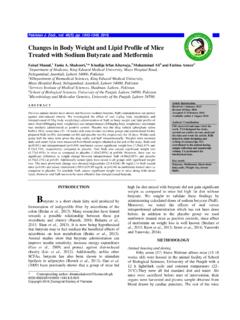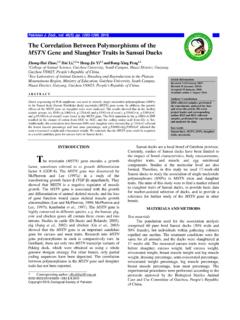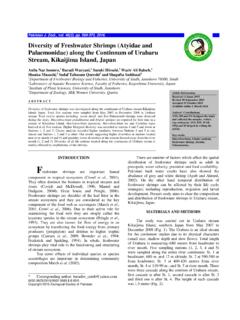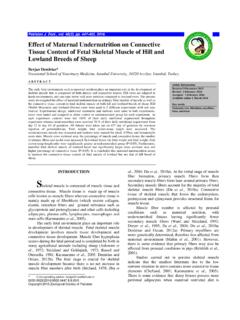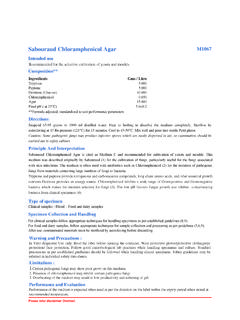Transcription of Isolation and Characterization of Heavy Metal …
1 Pakistan J. Zool., vol. 48(5), pp. 1241-1247, 2016. Isolation and Characterization of Heavy Metal resistant fungal Isolates from industrial Soil in China Sadia Qayyum,1 Ibrar Khan,2 Farhana Maqbool,3 Yangguo Zhao,1 Qingbao Gu4 and Changsheng *. 1. The Key Lab of Marine Environmental Science and Ecology, Ministry of Education, Ocean University of China, Qingdao 266100, China 2. UNESCO Chinese Center of Marine Biotechnology, Ocean University of China, Qingdao 266003, China 3. Department of Microbiology, Hazara University, Mansehra, KPK, Pakistan 4.
2 State Key Laboratory of Environmental Criteria and Risk Assessment, Article Information Chinese Research Academy of Environmental Sciences, Beijing 100012, China Received 18 May 2015. Revised 09 January 2016. Accepted 30 January 2016. ABSTR ACT Available online 1 August 2016. The soil contamination with the Heavy metals is the growing concern throughout the world as the Authors' Contribution result of industrial , mining, agricultural and domestic activities. The fungi are the most common and SQ and PC conceived and designed efficient group of the Heavy Metal resistant microbial family which have potential for Metal the study.
3 SQ executed the bioleaching. The present study was aimed on the Isolation and phenotypic Characterization of the experimental work, analyzed the data and wrote the article. QG. Heavy Metal resistant fungal strains. All the strains were grown on SDA, CYA, MEA media and helped in sample collection. IK. genotypic Characterization of all the strains were performed by using specific Internal Transcribed performed PCR analysis. FM and Spacers (ITS) sequencing examination. Different strains were identified as Rhizomucor pusillus F1 YZ helped in preparing manuscript.
4 (WF), Rhizomucor pusillus F2 (YBF), Aspergillus flavus F3 (LG), Aspergillus terreus F4 (YF), Aspergillus tubingensis F5 (BF) and Neosartorya hiratsukae F6 (DG). The present study reveals that Key words the Heavy metals contaminated industrial soil might be considered as a precious natural source of Heavy metals, bioremediation, resistant fungal strains, which can be used significantly as a bioleaching or bioremediation tool. Metal - resistant fungi, ITS, bioleaching. INTRODUTION means of mechanism produced in direct response to Metal species concerned.
5 Without any proper treatment process Heavy metals release into the environment poses a serious S oil contamination has become a serious problem threat to public health. Microbial population in Metal polluted environments possesses toxic concentrations of with the economy and industry development. It is major sink for Heavy metals released into the environment by Heavy metals and develops resistance Prasenjit et al., aforementioned anthropogenic activities and unlike 2005). fungal and yeast biomasses are known to be organic contaminants which are oxidized to carbon (IV) resistant to Heavy metals contamination in soil oxide by microbial action, most metals do not undergo (Gavrelesca, 2004; Baldrian, 2003).
6 They can adapt and microbial or chemical degradation ( Kirpichtchikova et grow under various culture conditions of pH, al., 2006), and their total concentration in soils persists temperature, nutrient availability and high Metal for a long time after their introduction (Adriano, 2003). concentrations, therefore these microorganisms are Heavy metals constitute an ill-defined group of inorganic considered as a versatile group. Recently microbial chemical hazards, and those most commonly found at systems like fungi, bacteria and algae have been explored contaminated sites are lead (Pb), chromium (Cr), arsenic for their role in the removal of Heavy metals from (As), zinc (Zn), cadmium (Cd), copper (Cu), mercury polluted environments (Natarajan et al.)
7 , 2011). (Hg), and nickel (Ni) (Gwrtac, 1997). In naturally fungal leaching of Heavy metals is an interesting polluted environments, the concentrations and availability biological treatment method (Yu et al., 2001). It is based of metals and the actions of different factors such as type on the fungal production of weak organic acids that of metals, nature of medium and microbial species solubilize metals by forming water soluble complexes govern the response of microbes to Heavy metals toxicity with them (Bosecker, 1997; Burgstaller and Schinner, (Herrera-estrella et al.)
8 , 2001). Metal resistance is defined 1993; Burgstaller et al., 1994). Aspergillus niger and as the ability of an organism to survive Metal toxicity by Penicillium simplicissimum have been observed to _____ produce abundant amount of organic acids (Ren et al., * Corresponding author. C. Peng) 2009). Fungi are known to be resistant and having ability 0030-9923/2016/0005-1241 $ to detoxify the metals by several mechanisms including Copyright 2016 Zoological Society of Pakistan valence transformation, active uptake, impermeability 1242 S. QAYYUM ET AL.
9 And sequestration, extra and intracellular precipitation, measured potentiometrically in 1M KCl with a soil /. biosorption to cell wall, crystallization and extractant ratio of 1:5 in three replicates per sample. The transformation of metals (Mala et al., 2006; Turnau et al., digestions were conducted with a mixture of 7molL-1 of 2006; Islam et al., 2008). As Compared to lithotrophic conc. HNO3, 2 cm3 of conc. HF and 1cm3 of 40% H2O2. bacterial leaching, this technique has advantage of being solution on a sand bath at a temperature of 200 - 2300 C, operated at mildly acidic conditions that minimize the for the determination of the total Metal contents of the loss of sediments properties, eventual foaming and H2S soil samples.
10 The AAS analyses for the determination of evolution phenomena that result from a sudden addition the total Metal contents of the soil samples were done. of strong mineral acids. El-Morsy (2004) also studied 32 fungal species Isolation of resistant fungi which were isolated from polluted water in Egypt for fungal strains were isolated from soil samples by their resistance to metals and found that Cunninghamela serial dilution method using Sabouraud Dextrose Agar echinulate biomass could be applied as a biosorbent of (SDA) containing Pb, and Cr 100 mgL-1 individually.
